What’s the difference between VOC paint and No-VOC paint?
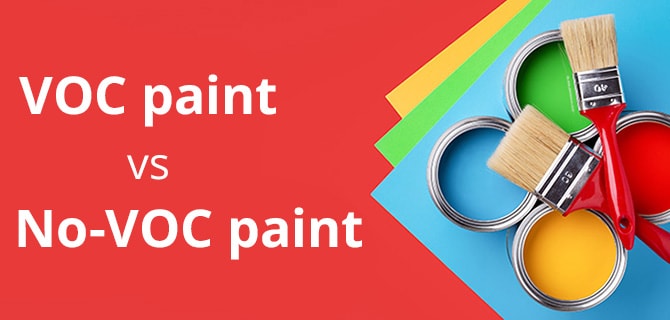
From being increasingly eco-conscious to health-conscious, consumers are focused on using products that are healthier, and this extends to paint. In the mid-1990s, low to no VOC paint began to hit the market and they have been growing in popularity ever since.
Paint manufacturers have better access to the raw materials required to make these eco-friendly paints, which is part of the reason they are more plentiful and why they have become more affordable. Furthermore, some of the best paint manufacturers have developed VOC-free ways to produce colorants for paints, making the no-VOC paints truly free of any trace amounts of VOCs.
The most important difference between VOC paint and paint that is free of VOCs is in regard to health concerns. VOCs are dangerous because once the paint is applied to the surface, the VOCs in the paint offgas into the air and cause a layer of ozone to disperse within a closed-in area.
Paint manufacturers design paint recipes for just about every condition a surface could be subjected to, and while some VOCs will remain in some recipes, a growing number of manufacturers are focused on creating safer products for customers to use.
Check out the following to figure out which is best for you:
- What are VOCs in paint and are they harmful?
- The importance of Low-VOC and No-VOC paints
- Low-VOC paint vs. Zero-VOC paint: What is the difference?
- What is Low-VOC paint?
- What is Zero-VOC paint?
- Why are Low-VOC or No-VOC paints the better option?
- Commercial interior & exterior painting using VOC-Free paints
- Explore the best Low-VOC or No-VOC paint brands
- Can you trust Low-VOC or Zero-VOC labels?
- Top myths and misunderstandings about VOCs in paints
- Choose a reliable painting contractor who uses Zero-VOC paints
What are VOCs in paint and are they harmful?
So, what is VOC in paint? VOCs are Volatile Organic Compounds that can be a health hazard. They become dangerous when they are emitted into the air and breathed in. They are harmful, according to the Environmental Protection Agency (EPA), either in the short term or in the long term or both. Paint is not the only product that emits VOCs, as various household cleaning agents include them, as does new furniture and various other building materials that can produce gas for hours or months, depending on the amount of VOCs in them.
There are a variety of chemicals that fall into the VOC meaning in paint. These include chemicals you might have heard of, such as ethanol, acetone and formaldehyde, but they are also present in common chemicals like benzene, d-limonene and methylene.
These chemicals were introduced because they can be valuable in fighting off algae and mildew growth in areas where surfaces experience frequent moisture. But VOCs are also used to help paint dry faster, which speeds up painting projects where multiple coats are involved.
Fortunately, paint manufacturers have figured out ways to reduce or completely eliminate VOCs from paint products while attaining the performance expectations that painters require for outstanding outcomes.
The importance of Low-VOC and No-VOC paints
Eco-friendly products have become extremely popular. There are even tax credits to gain by using them. But it wasn’t always this way, as up until 1978, many painters were still using paint that included lead in it, which is poisonous and causes a variety of health issues. VOCs have also come under fire, which has led to a movement to use low- to no-VOC paints.

While not all VOCs are acutely toxic, they are carbon-based chemicals that quite easily evaporate into the surrounding air after being applied to surfaces, and can lead to compounding and long-term issues that negatively affect the quality of life. In the short term, exposure can cause headaches and nausea. The long-term impact is far more serious, as the central nervous system can be impacted, as can the liver and kidneys.
For anyone who has experienced a “new car smell,” or a “new home aroma,” they could be breathing in/smelling VOCs. What happens is that the fumes enter the upper respiratory tract, which is where the VOCs are introduced into the bloodstream and allowed to impact other organs.
Asthma is a common problem with VOC exposure. Sinusitis, which is inflammation and/or swelling of the sinus tissues, is also common after VOC exposure. Most victims experiencing short-term effects will complain of burning in the eyes, nose and throat.
Traditional paints might be a bit more cost-effective than low- to no-VOC paint, which is also low-odor paint, but the added expense is worth it when health issues and the cost of treatment is concerned.
Low-VOC paint vs. Zero-VOC paint: What is the difference?
Low-VOC paint is not the same as zero-VOC paint for obvious reasons, but in the low-VOC vs. zero-VOC paint debate, what exactly is the difference? Fortunately, there are laws and regulations that dictate what qualifies as “low VOC.” The only bad part is that states have different definitions in their regulations, which means what’s considered low in one state might not qualify in another.

Just because low VOC paints have less harmful compounds in them doesn't mean they are perfectly safe, as frequent exposure to even small amounts can add up over time and develop into a health issue. But when you purchase a paint that says it is zero VOC, the manufacturer is claiming they didn’t add any chemicals that qualify as VOC and therefore the paint shouldn’t be harmful. But technically, zero VOC paint can contain less than 5 grams of VOCs per liter.
What is Low-VOC paint?
What is low-VOC paint? Green Seal, a non-profit environmental standard development and certification organization, has an answer to that question. To meet the “Green Seal standard,” low VOC paint must contain fewer than 50 grams per liter of VOCs. So, the low VOC definition that most follow is 50 grams. This also means that low-VOC paint simply has less than common paints that do not claim to be low-VOC.
Is low VOC important in all painting applications? Some would argue that some exterior paints, which can offgas VOCs for six months, should not be an issue, as the harmful gas dissipates into the air before it can be inhaled at harmful levels by anyone near the painted surfaces. Environmentalists would probably disagree.
What about ultra-low VOC? By some definitions, this is paint that has between 5 and 30 grams of VOCs per liter. This is not uncommon in water-based paints. However, in traditional oil-based paints, you will see significantly higher levels of VOCs, as they are used to help the paint dry faster (oil-based paints are known to dry much slower than other types of paint).
What is Zero-VOC paint?
Painting contractors often are asked the question: “What is the zero-VOC paint meaning or definition?” The simple answer is that “zero VOC” refers to paint that has 5 grams or fewer VOCs per liter. But if the recipe doesn’t call for VOCs of any type, why would there be trace amounts emitted? For most VOC-free paints, it’s the dyes that provide the color to the paint that will contain those trace elements. Should those colorants drive the VOC levels beyond 5 grams, the paint cannot be considered “zero” VOC.
Zero VOC paints are quite popular in areas where absolutely no chemicals can be present, such as in healthcare facilities. For property owners that insist on zero-VOC paint products, they are urged to consult with a trusted painting contractor to ensure the paints used in the project are indeed zero VOC.
VOC-free paint requires no special drying phase. This is a huge advantage for businesses that can’t afford downtime. For example, when paints containing VOCs are used, the interiors need to be vacated until the paint dries and the VOCs dissipate. It’s only then that employees and/or customers can re-enter the area.
While low-VOC paints are quite popular, it should be noted that they can be harmful to anyone who has prolonged exposure to them. It’s important to know the distinction between zero- and low-VOC paints, so be sure to get clear answers from your painting contractor and heed any and all warnings regarding exposure.
Why are Low-VOC or No-VOC paints the better option?
There is an advantage to using low- and no-VOC paints, mainly in that they cause very little odor. And while avoiding paint odor is preferable, avoiding exposure to the chemicals that fall under the VOC definition is even more important.
VOCs are included in paints for a variety of reasons, but one of the most attractive to painters is that they help the paint to dry fast. Fortunately, paint manufacturers have developed paints that dry just as fast but without VOCs.
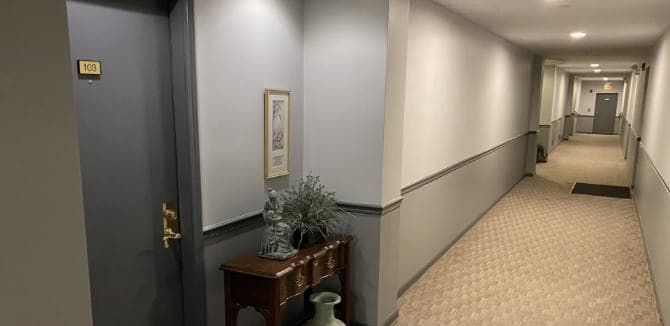
The advantages of Low or No-VOC paints
The advantages of low VOC paint are numerous, including the fact that they offput little to no odor, but they also dry just as quickly as paints that contain VOCs. Low-VOC paint benefits also include the fact that they have come down in price compared to what they cost years ago. Furthermore, low- to no-VOC paints are also durable and perform well in a variety of situations. They are so popular today that they are easy to find in many, many colors.
- Environmentally friendly
Taking care of Mother Nature should be everyone’s priority today, and with the development of low- and no-VOC paints, a painting project, whether it’s residential or commercial, doesn’t have to pose an environmental threat, nor do they have to pose a threat to anyone’s health. - Less odor
While some people might enjoy the fresh paint smell to some degree, the goal in most painting projects is to avoid the paint odor as much as possible. Less odor means fewer chemicals that can pose a health risk. It’s not uncommon for some paint manufacturers to market their zero-VOC paints as “low-odor paints.” - Releases fewer compounds
Fewer compounds mean fewer health risks, and that’s what zero-VOC paints offer. Paints that contain VOCs can cause long-term health issues, which is why painters who use them must wear protective equipment and shut down the area until the paint has dried and the VOCs have sufficiently offgassed. - Safer for employees and customers
Employees are the lifeblood of any company and the safety of customers is also a huge concern. Using low- to no-VOC paints provides a safer environment for employees and customers alike. When you partner with a painting contractor that uses safer paints, you can rest assured that when you return to your property, it will be clear of toxic vapors and safe for everyone. - Affordable
It wasn’t that long ago that using low-VOC paints brought considerable expense to a painting project. Fortunately, they can be made much more cost effectively than they once were, which means they are less costly for the customer. In fact, some low- to no-VOC paints are similarly priced to paints that contain VOCs.
The disadvantages of Low or No-VOC paints
With all the good things to say about non-toxic paint, are there any disadvantages of low VOC paint usage? There is a pros and cons list for just about anything and paint is no different. The following are the most often mentioned cons about low- or no-VOC paint.
- Additional chemicals and solvents
While paints that are marketed as low- to no-VOC, some paint manufacturers add solvents to theirs in an effort to improve its performance. Be sure to do your research and get a list of ingredients, because some of these solvents can be detrimental to the health of those exposed. - Potentially shorter lifespan
The best paints are durable, which means they last a long time, which is popular with the customer, as they won’t have to take on another painting project for a long time. However, some low- to no-VOC paints do not last as long as others. This can lead to more frequent touch ups or all-out repainting of various areas.
Everyone deserves to breathe easy, and using low- and zero-VOC paint will ensure that happens. If you want to protect your employees and customers in your commercial space, you can definitely do that by talking to your painting contractor about all the available paint options. Fortunately, the aesthetic appeal of quality non-toxic paint is just as good as paint with VOCs in it. And don’t forget – the environment will thank you for your efforts in using safer paint.
Commercial interior & exterior painting using VOC-Free paints
Commercial painting projects increasingly utilize VOC-free paint in an effort to improve safety and eco-friendliness. For example, no-VOC interior paint allows companies to keep their environments safe and diminish downtime related to airing out fumes/odor. The following are typical environments where no- to low-VOC paints are popular.
The properties preferring Zero-VOC paints:
- Churches and religious properties
- Commercial offices
- Apartments, condos, HOA’s
- Retail stores
- Educational facilities
- Healthcare facilities
- Gyms and fitness centers
- Restaurants and cafés
- Hotels, motels, inns
There is a lot to think about when taking on a painting project. For most commercial spaces, the concern is color and finish. Project managers work closely with painting contractors to bring in the right range of colors based on employee productivity and customer expectations. Another important option to consider is low-odor paint, which is increasingly a concern.
Fortunately, the top paint brands have taken the wants/needs of their customer base into account and now offer a variety of no-VOC interior paints, as well as no-VOC exterior paint. These options protect employees and customers on the inside, as well as protect the environment outside.

Explore the best Low-VOC or No-VOC paint brands
It wasn’t that long ago that acquiring the best low VOC paint for a project was quite difficult, as they were in low demand and low supply, therefore the color options were limited. Things have changed and commercial customers now have their choice of all the top colors for their particular industries.
Some of the best low-VOC paint is made by Sherwin-Williams and Benjamin Moore – two of the top paint manufacturers out there today. The following are some of the best on the market today.
Benjamin Moore’s Zero-VOC paints
Benjamin Moore low-VOC paint is a big hit with painting contractors whose customers demand perfection. The company has proven time and again that it is committed to safety and protecting the environment by producing some of the top paints in the no- to low-VOC paint category. For example, its Gennex Color Technology brings zero-VOC colorant to the market.
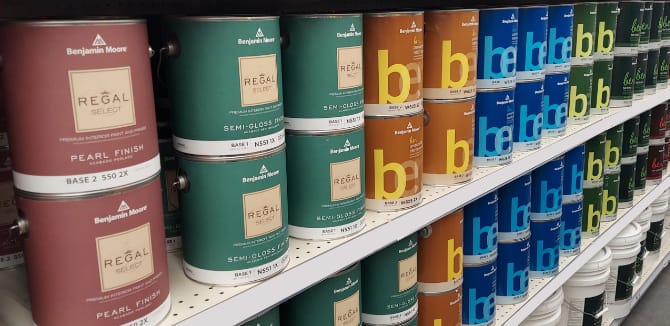
Benjamin Moore Eco Spec interior paint
Benjamin Moore zero-VOC paint delivers a top option in its Eco Spec line, which is considered the most environmentally friendly acrylic paint on the market. It comes in flat, eggshell and semi-gloss finishes and is available in just about any color. For facilities where keeping at-risk employees and customers is a priority, Eco Spec has been Green Seal certified and is also certified as asthma and allergy friendly by the Asthma and Allergy Foundation of America.
Benjamin Moore ben Interior Zero-VOC paint
Benjamin Moore's ben® Interior Zero-VOC paint is an environmentally conscious choice that doesn't compromise on performance. With its Zero-VOC formulation, it minimizes harmful emissions, making it ideal for improving indoor air quality. This paint line offers durability, easy cleaning, and excellent coverage, suitable for various interior spaces. It's also low-odor and available in a wide range of colors, making it a favored option for professionals who prioritize both sustainability and quality in their paint selections.
Sherwin-Williams’s Zero-VOC paints
Sherwin-Williams is one of the most trusted brands on the market today and is a favorite of contractors who care about quality. The company is also committed to the demands of customers who call for safer, more environmentally-friendly paints. Sherwin-Williams zero-VOC paint is one of the safest paints on the market. The Sherwin-Williams low-VOC paint is also popular with contractors and customers alike, as it offers some of the best finishes available.
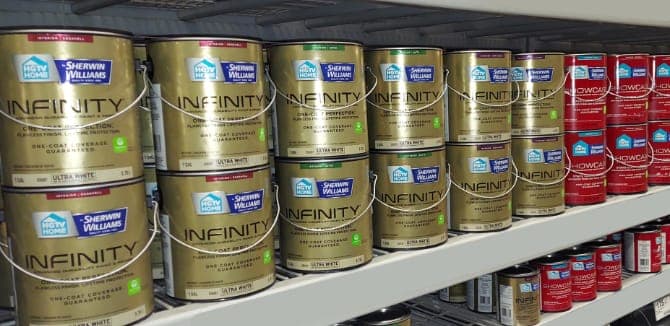
Sherwin-Williams ProMar 200 Zero-VOC interior latex paint
Sherwin-Williams Promor 200 zero-VOC paint is one of the top-quality paints in this category. It is an interior latex paint available in six sheens and just about any color you can dream of. For example, if you want paint that has met MPI certification, choose the Promor 200 in a flat sheen, which has excellent hide qualities and is incredibly durable.
Sherwin-Williams Harmony Interior Acrylic Latex paint
A top-selling acrylic option is Sherwin-Williams’ Harmony, which is water based and offers zero VOCs. Harmony utilizes technology that not only emits no odor, it also works to eliminate various household odors. Sherwin-Williams Harmony paint truly brings a clean air solution to interiors and is UL GreenGuard Indoor Air Quality certified, as well as UL GreenGuard Gold certified.
Sherwin-Williams EcoSelect Zero-VOC interior latex paint
Sherwin-Williams EcoSelect zero-VOC interior latex paint is a favorite in projects where the budget is a big concern. And while this option might be economically friendly, it’s also spatter resistant and completely environmentally friendly and safe to use on interiors. It’s also versatile, as it can be applied to wallboard, ceilings, masonry, wood and primed plaster.
Whether the project involves Benjamin Moore or Sherwin-Williams no- to low-VOC paints, it’s going to be a success, as these are two of the most reputable paint brands on the market today. Talk to your painting contractor about what will work best on your surfaces and rest assured that your project will look great and last a long time.
Can you trust Low-VOC or Zero-VOC labels?
Reading the fine print on low VOC paint and zero VOC paint is always a good idea. Primers can also contain VOCs, so make sure to read the label on your zero-VOC primer, as well. It’s important to note that the Environmental Protection Agency (EPA) only regulates “some household products,” according to its website. The EPA is only concerned with VOCs that photochemically react in the atmosphere to create ozone. Therefore, the EPA is not going to flag non-photochemical ingredients, which can still be health hazards. A good example of this is in regard to ammonia and acetone, which are health hazards and present in some paints, but aren’t photochemicals.
Beware of “greenwashing,” which is the misleading marketing practice of touting various environmentally friendly aspects of a brand, yet the ingredients are far from safe. To avoid having your surfaces painted with potentially unhealthy products, only buy from trusted brands, such as Sherwin-Williams and Benjamin Moore. Furthermore, look for products that are certified by trusted third parties, which include Greenguard, Green Seal and Scientific Certification Systems.

Top myths and misunderstandings about VOCs in paints
Don’t be fooled by prevailing myths that create a false narrative. The following are some of the most common regarding non-toxic paint.
Myth #1: All VOCs are harmful
The fact is that while a majority of VOCs are harmful, some being harmful in the long term rather than short term, there are also VOCs where impact on health has yet to be proven. While some VOCs are toxic at a different level than others, the level and length of exposure is the key to determining the severity of health issues. What is known for sure is that when paints containing VOCs are used indoors, proper ventilation and personal protection equipment are required.
Myth #2: All VOCs are man-made
Many of the chemicals used in products today are man-made and have dangerous levels of VOC, but mother nature also produces them. For example, isoprene, a VOC, is created naturally by vegetation. It is estimated that around 600 million metric tons of isoprene are released into the atmosphere annually. Another common VOC that comes from plants is limonene, which has a citrusy aroma and is used in essential oils.
Myth #3: Zero-VOC paint products have no VOCs
Paint products that are truly free of VOCs do not contain any of them. However, to pass as zero VOC, they must remain less than 5 grams of VOCs per liter. In a situation where a paint adheres to the 5-gram standard, they are considered to have “trace” amounts of VOCs.
Myth #4: All Zero-VOC paints are the same
Due to the way some paint manufacturers market their products, not all zero-VOC paints can claim to be the same. Some manufacturers do better than others. For example, bargain brands might be able to keep their product clear of VOCs up until when they add colorant, at which point the VOCs are introduced.
Quality brands have developed colorants that do not contain VOCs or contain very small, trace amounts that keep them in the good graces of the 50 grams per liter standard. You must also take into account that some zero-VOC paint manufacturers use substandard colorants, such as dry pigment, to color their paints. These will not perform as well as the pigment used by quality brands.
Myth #5: Color options are limited with low- and zero-VOC paints
This myth only gains steam because so many brands fail to offer a wide range of colors in their low- to no-VOC paint offerings. However, Benjamin Moore has done an outstanding job of bringing an array of colors to the market. The company has developed a waterborne colorant system that allows for roughly 3,300 colors to be represented in their paints, VOC free.
Myth #6: Low- and no-VOC paints are not competitively priced
Is there a premium to be paid for using paints that are more environmentally friendly and safer to use around humans? The answer is yes. However, the prices of these paints have dropped and experts believe the cost of these products will continue to drop.
However, many of the raw materials used in low- to no-VOC paints are derived from the petroleum industry, which means that when the price of oil goes up, paint could similarly be affected, and vice versa. But overall, these paints are not as expensive as they once were.
Choose a reliable painting contractor who uses Zero-VOC paints
It pays to partner with a painting contractor utilizing the best paints. If you’re committed to using paints that are friendly to the environment and not toxic to people, you’ll want to choose a contractor that knows the best and most trusted brands, which ensures that the low- to no-VOC paints are legitimate.
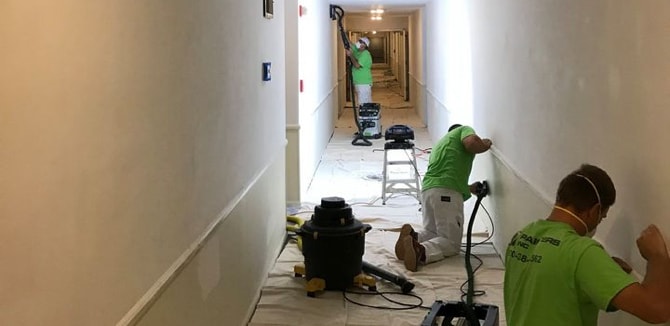
At Painter Inc., we only use the brands that we trust, and they are high performing and durable. The paints we choose, namely Benjamin Moore and Sherwin-Williams look amazing and last a long, long time.
Zero-VOC paint and zero-VOC primer can enhance a painting project, whether it’s interior or exterior. But they only matter if the painting contractor applying them knows what they’re doing. Only work with one that has years of experience and plenty of references. Also, only choose a painting contractor that is licensed, bonded and insured. At Painters Inc., we’ve got plenty of reviews from satisfied customers that prove that we bring value to the jobsite. We’ve also got examples of our work to showcase to potential clients doing their due diligence as they search for the right contractor.
Need more information about paint that is eco-friendly and safe for people to be around? Contact us and we can talk more specifically about your project, the paints and primers we will use and address all concerns you have about VOCs.









